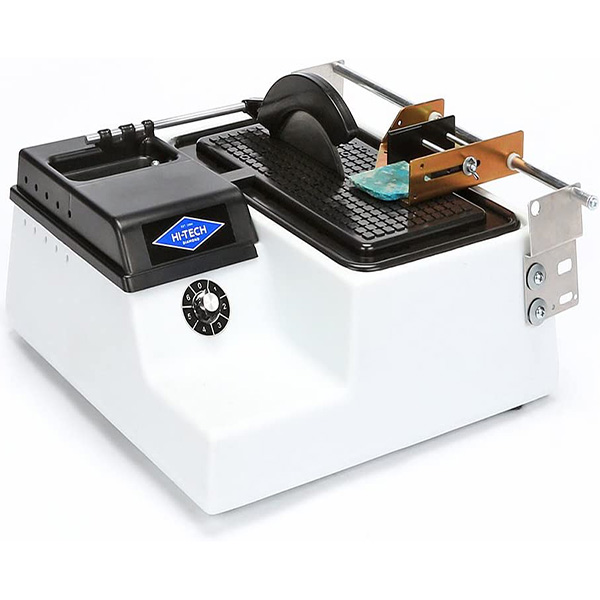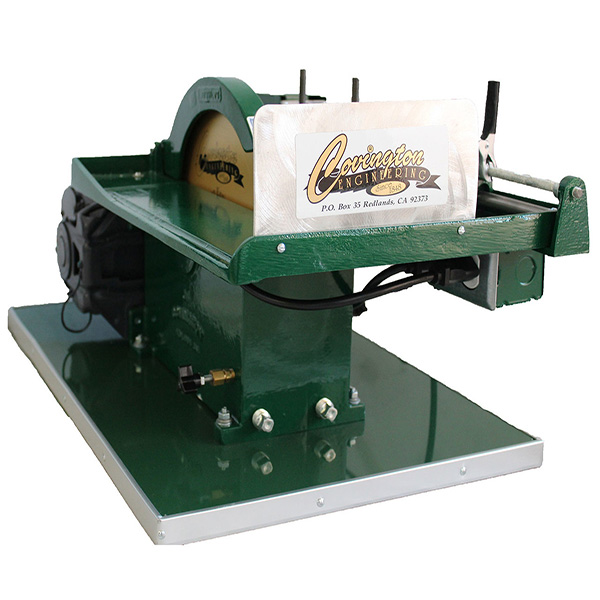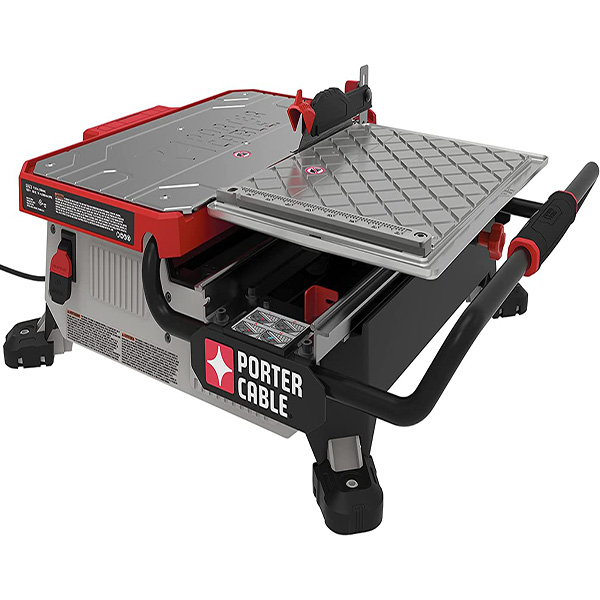Understanding Rock Saws Part 1 – Trim Saws
It is fair to say that most of the lapidary arts begin with the need for a rock saw, and unless you are simply picking up rocks that are ready to be tumbled or made into jewelry you probably need one. Rock saws vary greatly in style, size, and purpose. Figuring out which one is best for you can be confusing so we are providing this two part article to help you understand the differences and decide which type of saw is right for you. In this part one, we will cover trim saws, what they are, how to properly set up and maintain the saw, and what common features are available so you can make an informed decision on what saw is right for you.
Trim Saws
Description:
Typically a lapidary trim saw is a fairly small, liquid cooled unit that is placed or mounted on top of a work bench, resembling a small table saw. A motor driven diamond blade emerges through the top of a flat metal table, fixed at a 90 degree angle to the table. Trim saws and their accompanying blade sizes vary roughly from 4 – 10 inches with the most common units being 6 -7 inches. Often on trim saws the blade is driven by pulleys and belts with the motor being situated away from the cutting unit.
Setup and Maintenance:
- Because of the constant presence of liquid around these saws, make sure to set up your machine where a properly grounded circuit, equipped with a GFI device outlet can be used. To use these devices on anything other than a fault protected circuit is dangerous.
- Detached motors should be positioned far enough away and shielded to protect the motor from spraying liquid.
- Most trim saws have an internal liquid reservoir on board and during operation the liquid level must be maintained so as at least 1/4 of an inch of the blade is covered in the liquid.
- Due to the “push thru” nature of most trim saws, blades go dull and wear out quickly so ‘dressing’ with a quality diamond blade dressing stone to expose fresh diamonds is important.
- Belt tension is important and should be checked periodically to make sure the belt is tight and free of liquid and debris.
Clean Up:
- If you are using water as a blade coolant in your saw, it is critically important for the life of your blade that you drain or lower the water level in the reservoir after every use so that the blade is not left in standing water. Leaving a blade in standing water will cause it to rust very quickly and cause potentially permanent damage to the blade. We can’t stress it enough not to leave a diamond blade in water for even a few hours or overnight because they will begin to rust immediately.
- After lowering or draining the water level, spin the blade and wipe it dry for extra protection against rust. Once dry, it’s a good idea to give your blade a light coating of oil.
- Periodically clean the liquid reservoir because it will get full of muck and rock scraps very quickly. As debris builds up towards the bottom of the blade, maintaining the proper liquid level becomes more difficult as the reservoir becomes shallow.
- It’s good practice to clean your saw’s cutting table surface after every usage. A clean surface makes operating easier, and debris buildup can divert the liquid away from dripping back into the reservoir where it belongs.
- It’s also a good habit to clean your splash screens and hoods after each cutting session because dried muck will build up very quickly and stain the plastic brown.
Basic Operation:
- With lapidary grade rock cutting regardless of the type or size of the saw, we recommend purchasing the highest quality blade as you can afford, which usually comes with a thin kerf which means the thickness of the blade. A thinner kerf blade reduces the amount of often very expensive material being ground away during the cut. If you need blade recommendations please ask us in the Cutting Rocks – Slabs and Saws section of the forum.
- Trim saws can be operated using either water or some type of oil for blade cooling, and most better quality diamond lapidary blades say to only use oil. When it comes to trim saws however, using oil is not very practical because the cutting occurs in the open air in the presence of the operator, and the liquid spray is not contained inside the saw like it is with a slab saw. In trim saws, water can be used successfully if you pay close attention to the clean up procedures we listed above.
- Whether you are using water or oil, always make sure you have a good flow of liquid coming off of the blade before starting to cut any rock. A dry blade will overheat and ruin the blade and probably the rock too very quickly.
- When using water, be gentle and don’t push your rock through the blade with quite as much pressure as as you might be able to using oil. Water does not provide as much lubrication at the point of the cut, and the blade will wear quickly if pressed hard.
- Plan your work, especially if you are cutting a flat slab into cabochon preforms and leave a margin at the spots where the cut will be completed. Due to the curved nature of the blade, and depending on the thickness of the slab, the cut underneath the slab has traveled farther in the cut than the cut you see visually on top. A really clear and educational explanation for this can be found in this tutorial on building a homemade jig to cut inside corners on a trim saw.
- Go slow and don’t overwhelm the saw. These are not table saws that can rip through wood in nothing flat. These are basically very thin grinding wheels with exposed diamonds and depending on the thickness and type of material it takes time to grind through a rock for a successful cut.
- If you are cutting rough rocks that are not flat, make sure to stay in the cutting zone of the saw. As an example, a 6 inch trim saw has less than half, or roughly 2.5 inches, of usable blade rising above the table of the saw. This is not exact science and it depends greatly on the shape and hardness of the stone being cut, but the maximum height of a stone for cutting on a 6 inch saw is around 1.5 inches maximum. If you attempt to cut a 2.5 inch round agate on a 6 inch saw it will be a very long slow cut if the saw can even make it through, or if you can hold onto the rock for that long.
- It’s also important to know your length of cut. Most of these saws have a fixed mounting bracket for the blade splash guard, and it is this measurement from the front of the blade to the start of the bracket that determines how long of an uninterrupted cut you can make. Some saws might allow you to raise the splash guard above the blade to finish the cut but this almost always results in a lot of spray aimed directly at the operator.
- As stated above in the maintenance section, keep your saw cutting surface as clean as possible. Sludge and rock scraps build up quickly during your cutting session especially if you are cutting thundereggs or similar. A debris-filled work table makes it difficult to maintain the accuracy of what you are trying to cut.
What follows are examples of features found on various trim saws. This is not a review or recommendation of any of the specific models mentioned as examples.
Fully self-contained trim saw
The Hi-Tech Diamond 6″ Lapidary Trim Saw is just one example of a fully self-contained trim saw which is effectively “plug and play.” This means that if you brought this saw home, you would open the box, set it on your work bench, install the saw blade and add water, and then start cutting. The advantages of this type of machine are mainly ease of set up and operation, and cleaning.
Combination unit – trim saw / grinder polisher
Many trim saw models such as this Lortone Lu6X-130 Combination Machine have the trim saw fully integrated with a polishing grinding unit. The advantages of this type of machine are mainly space and energy savings. One motor is powering a single unit instead of having two machines running at the same time to accomplish a task. It’s reasonable to think that a more experienced lapidary artist with space to grow would lean towards the versatility of having two separate machines, simply just in case either one needed to be upgraded.
Push through with guide rail
The majority of bench top trim saws are “push thru,” meaning that you push your rock through the blade while the blade remains stationary. Models such as this Hi-Tech Diamond Trim Saw with Vise Attachment provide a vise mounted to a guide rail to assist you with the task. If your primary use of the saw is to trim up small rough rocks in preparation for tumbling, then you might enjoy this feature thoroughly. If you are a mainly trimming slabs into preforms, you might find that the vise feature takes up too much space and gets in your way.
Gravity or Power feed features
Some models, like this Covington Engineering 10″ Trim Saw with guide rail and vise, also have a powered a gravity feed feature to move the rock through the blade without having to push it by hand. If the rocks you are cutting are a bit on the larger side, these features might be great for you. Many lapidary artists find that auto feeds in general on a trim saw are problematic and require too much fiddling, and they opt for a slab saw with auto feed instead.
Operator Shielding
Most smaller trim saws use water for cooling the blade and come with a tight fitting, but movable cover over the top of the blade. Some units like the Lortone TS10-C Trim Saw go a step farther towards keeping the operator dry with a plexiglass cover over the entire cutting area with holes on both sides for the operator’s hands. The downside of clear plastic shields and covers is they get very dirty and will stain and ruin visibility if you don’t give them a good cleaning between uses.
Tile Saws
We get the question a lot on the Rock Tumbling Hobby Forum as to whether or not a tile saw like this Porter-Cable Wet Tile Saw from Amazon can be used to cut rocks. The answer is “yes” if you understand certain things first. Tile saws spin twice as fast as lapidary saws and at this speed it’s not easy to hand feed a small rock through the blade without having a tight grip on it. This often requires the lifting of the spray shield which causes the operator to take a shower. The speed becomes an issue as the increased blade speed can dull the blade more quickly than the slower-running lapidary saws. This can translate to more time spent on blade maintenance and blades being replaced more often. Lastly, if you are cutting flat lapidary slabs which approximate the thickness of tile, then the saw can be used efficiently, however you may want to swap out the tile blade for a good quality lapidary blade with a thinner kerf in order to minimize material loss.






